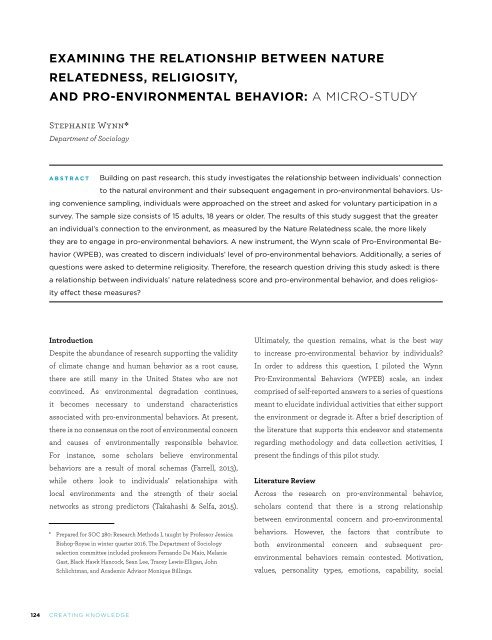UNDERGRADUATE
Ycb5305N2JX
Ycb5305N2JX
You also want an ePaper? Increase the reach of your titles
YUMPU automatically turns print PDFs into web optimized ePapers that Google loves.
connectedness, evolution theories, and worldview have<br />
all been studied as potential predictors of environmental<br />
concern and pro-environmental behavior. Of these,<br />
I will focus my review on morality and worldview as<br />
indicators of environmental concern, place-attachment<br />
or one’s connection to their immediate environment, and<br />
motivations for preservation embedded in evolution. I will<br />
go on to speak about issues with methodology and a lack<br />
of common measurement tools.<br />
In terms of one’s worldview, some scholars contend that<br />
each person has a different moral schema relating to the<br />
environment. These schemas can be broken into three<br />
different categories: un-enchanted, intrinsic, and creational.<br />
The un-enchanted moral schema does not see nature as<br />
sacred. The intrinsic schema states that nature is sacred in<br />
itself, and the creational schema believes nature is sacred<br />
because it is a divine creation. In studies like these, one’s<br />
group membership in a specific schema reliably predicts<br />
their level of environmental activism (Farrell, 2013).<br />
Other scholars have argued that place attachment—one’s<br />
degree of attachment to the social and physical place they<br />
live—can be a reliable predictor of pro-environmental<br />
behaviors (Takahashi & Selfa, 2015). They explain that<br />
increased attachment to other’s in your community and<br />
your physical environment results in greater engagement<br />
in pro-environmental behaviors. Varied results have<br />
been found linking community attachment and proenvironmental<br />
behaviors. This variation may be due to<br />
inconsistent measurement techniques. For example, both<br />
surveys and in-depth interviews were used with different<br />
samples, perhaps indicating a variation in methodology<br />
rather than behavior. Another issue with this study is in<br />
the way attachment to one’s physical environment can<br />
be measured. If one is asked about affinity, this may be a<br />
result of memories embedded in the landscape opposed to<br />
the actual landscape itself.<br />
As stated earlier, some scholars have drawn upon<br />
evolutionary theories and specifically, some scholars have<br />
oriented their research around the biophilia hypothesis<br />
(Nisbet et al., 2009; Kals et al., 1999). This hypothesis<br />
argues that humans have a strong need to relate and<br />
positively engage with other living things, including the<br />
natural environment. This has been substantiated by the<br />
popularity of outdoor recreation, as well as noted health<br />
benefits as a product of being in natural scenery. Given<br />
this hypothesis, scholars have sought to understand how<br />
much this need varies between people and its relationship<br />
to environmentally responsible behaviors. These studies<br />
look beyond exposure to nature, and question the<br />
emotional experiences in nature. Further, it has been well<br />
documented that positive past experiences in nature are<br />
strong predictors of environmental concern (Nisbet et al.,<br />
2009, Kals et al., 1999). However, it remains unclear to what<br />
degree past experience influences environmental concern,<br />
compare to, say, place attachment or one’s moral schema.<br />
Due to the lack of agreement on root causes or<br />
explanatory factors regarding environmental concern<br />
and environmentally responsible behaviors, there has<br />
subsequently been a lack of a common measurement<br />
scale. Variation in measurement scales has resulted<br />
in very different conclusions even in relatively similar<br />
studies. For instance, many studies testing a variation in<br />
urban versus rural levels of environmental concern are<br />
often contradictory due to a lack of using the same type<br />
of measurement scale (Takahashi & Selfa, 2015). As many<br />
of the studies testing these factors use surveys, lack of<br />
a common tool leads to conflicting results. The Nature<br />
Relatedness scale is one potential tool scholars could use<br />
to test individuals’ connection to the environment over<br />
time and place. Tested with a large sample sizes multiple<br />
times, this scale prevails as a reliable tool.<br />
Largely, studies investigating pro-environmental behaviors<br />
use self-reported surveys. Pro-environmental behaviors<br />
are typically characterized as ‘recycling,’ ‘composting<br />
household kitchen waste,’ ‘donating money to environmental<br />
organizations’ and ‘avoiding chemical use in your yard<br />
(Takahashi & Selfa, 2015). ’ Surveys are convenient and<br />
DEPAUL UNIVERSITY<br />
125


